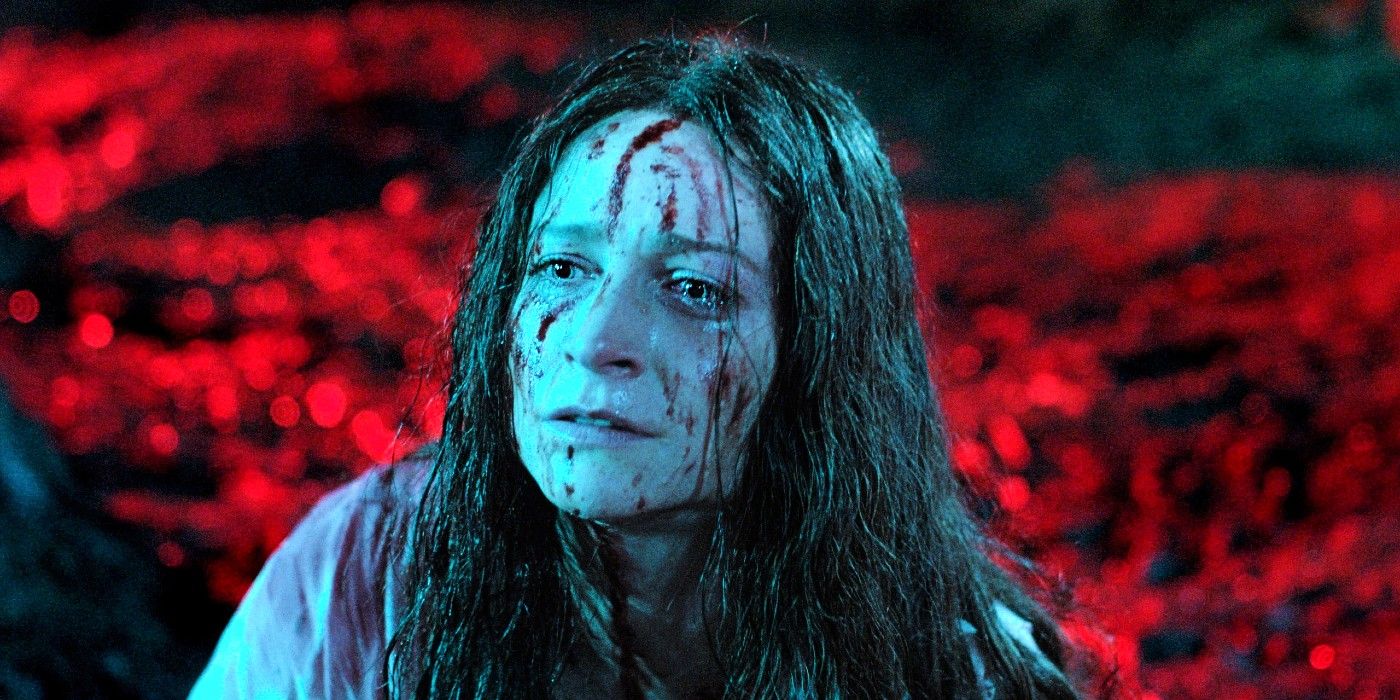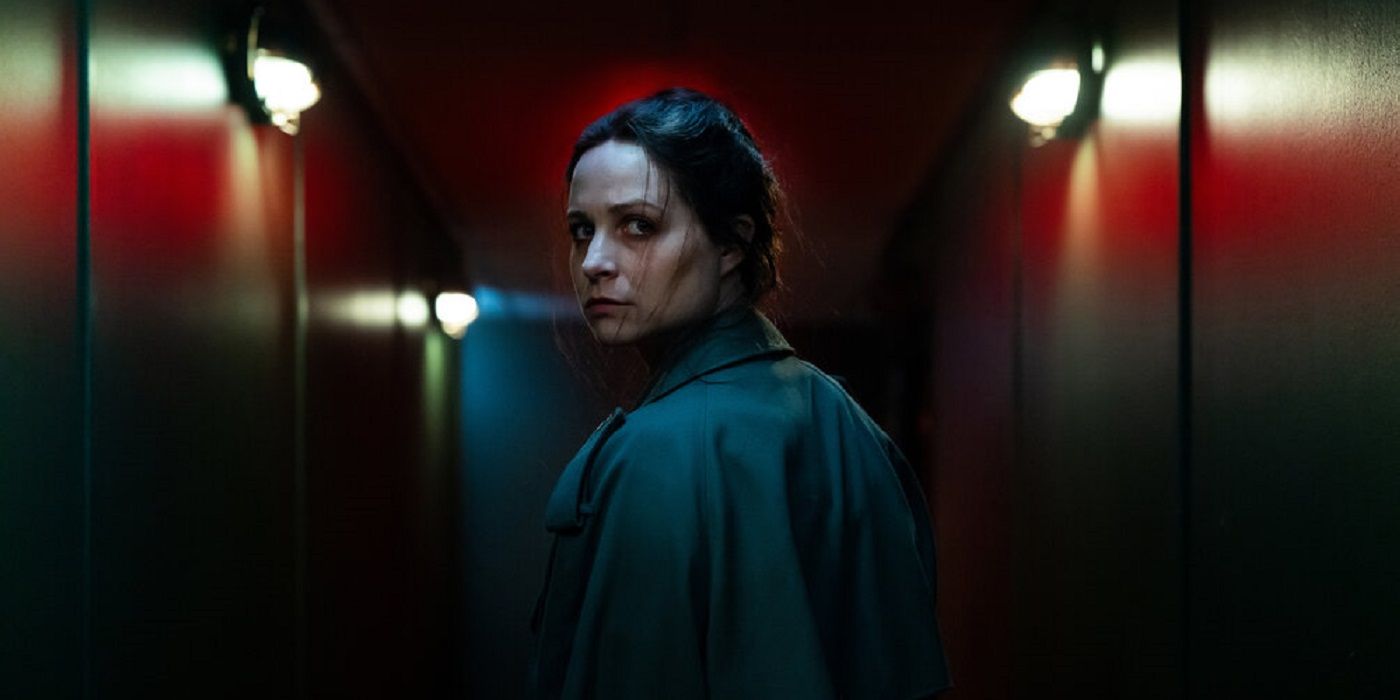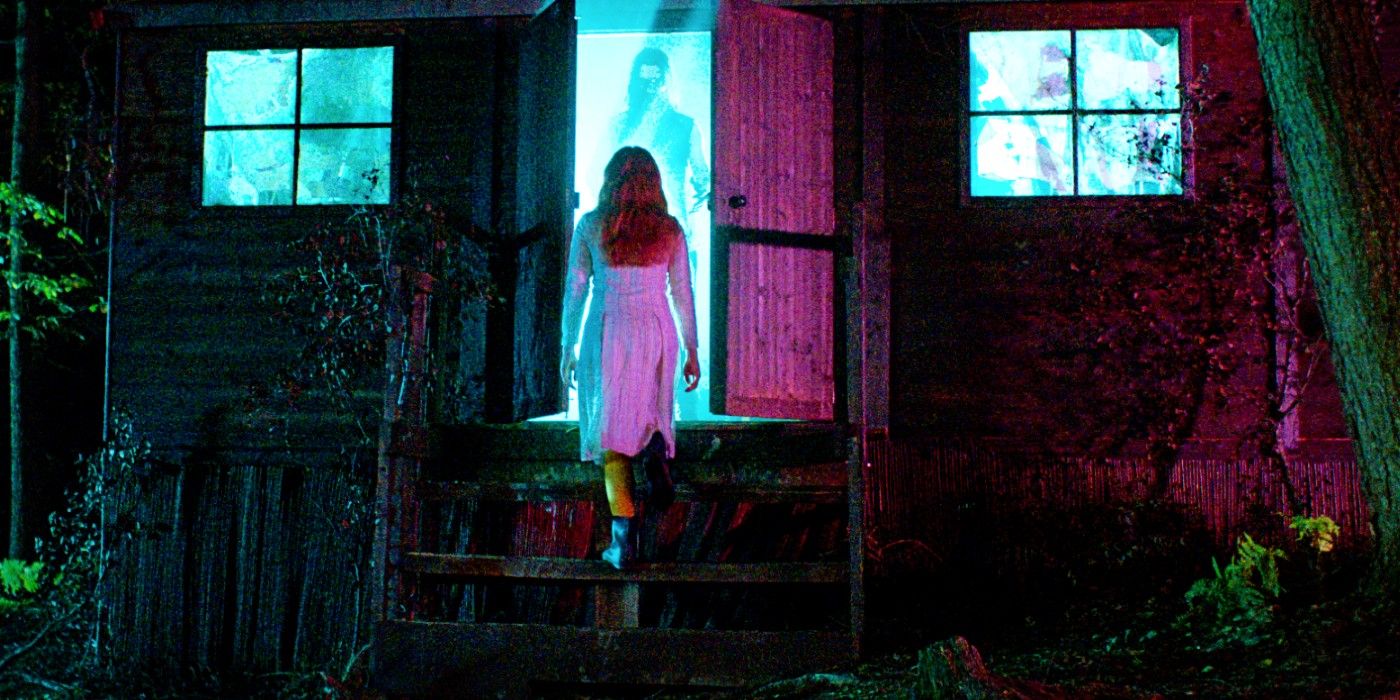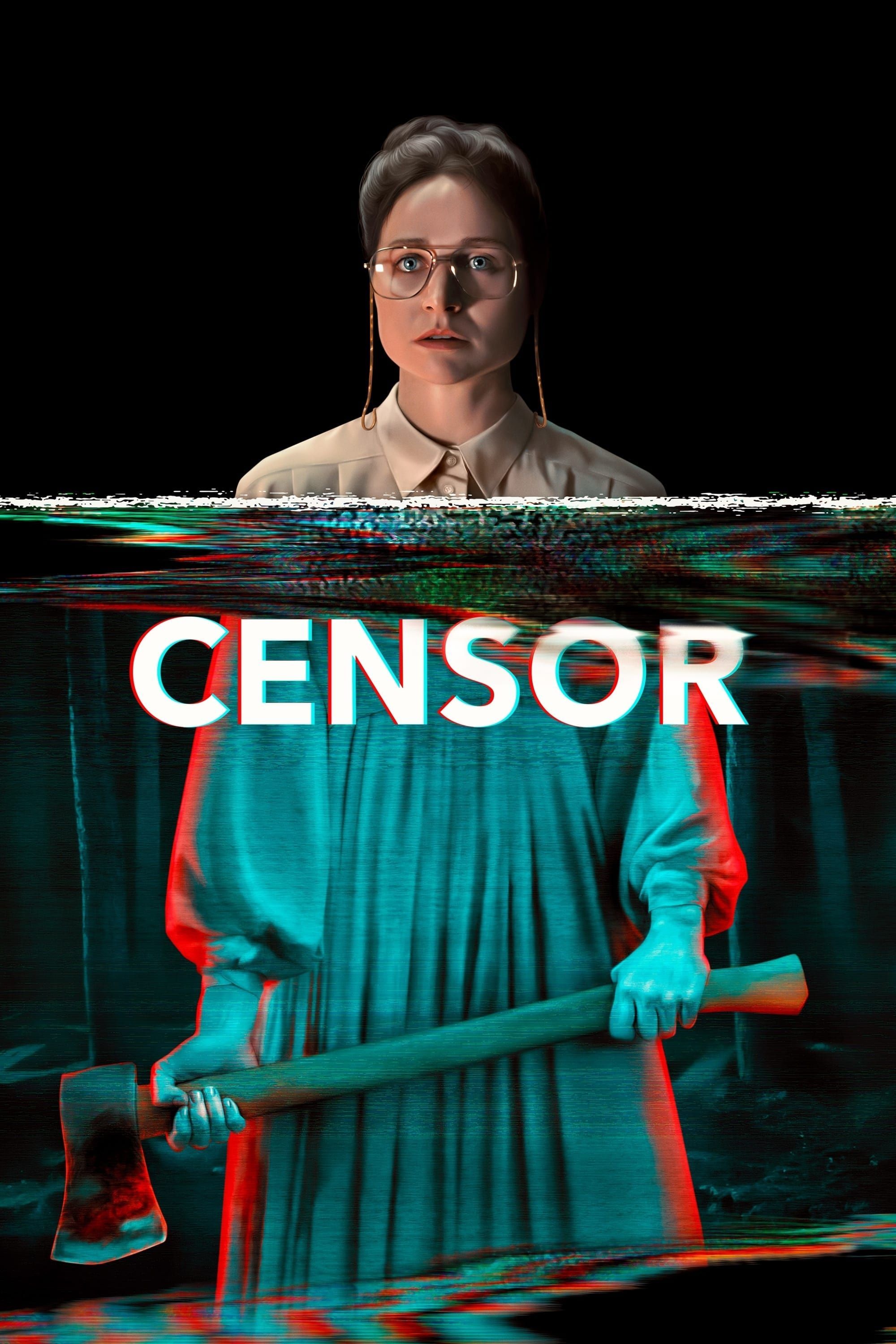Prano Bailey-Bond directs Censor starring Niamh Alger. Alger plays Enid, a film censor working for the British Board of Film Classification during the 80s UK craze dubbed the "Video Nasty" controversy. As backlash rises against increasingly horrific VHS movies, Enid discovers one horror film with an actress that looks like her sister Nina. The thing is, Nina went missing during childhood. This discovery sends Enid down a violent and visceral rabbit hole that calls back to some of the great horror films of years past.
Screen Rant sat down with Bailey-Bond to discuss Censor, the role censorship plays in film and society today, and her peculiar influences on the film. Censor is now streaming on Hulu as part of their HULUWEEN event.
WARNING: This interview contains spoilers for Censor.
Screen Rant: Did you have any particular films you looked to for inspiration for Censor?
Prano Bailey-Bond: When I was working on the film at the script strange there were various different influences for different things. One of the most abstract and unusual influences was actually Watership Down, the film about rabbits. It was a really big influence for me for the sound and the world of the censor's office and this sort of strange underground warren of the censors. In Watership Down, you have the whispers of rabbits going through tunnels and in the censor's office, we have the screams of people being murdered in films in the next room.
You find these films that can kind of be like a way into a certain aspect. But obviously the film and the nature of Censor - the setting and the period - meant I was going back and watching a lot of the "video nasties." So, Lucio Fulci's and [Dario] Argento's work were definitely revisited a lot in terms of looking at the designs of the films within the film. And then for the kind of psychological unraveling of the main character I was looking at films like Let's Scare Jessica to Death and Black Swan. The Piano Teacher as well I thought was a great reference for the character in terms of this very hard-shelled woman who we slowly see crack. You kind of pick a mix of different things that help you along the way. I also tend to look at photography and painting and music.
Placing a film censor at the center of a horror film is in its own way quite ironic, but we’re put in a position where we become sympathetic towards Enid and her job at the ending despite the fact that she’s doing something that many people who watch the film would probably kind of hate. Why drew you to spotlight a film censor and Enid as a character?
Prano Bailey-Bond: It's funny isn't it? When I was writing it I was thinking, "Oh god, this is the horror fan's enemy that I'm trying to get the horror fan to go on a journey with." But really it was this idea of making a film about a film censor that was where I started. It wasn't starting with the era or the "video nasties," it was the character of a film censor.
I had been reading an article about the Hammer Horror era and it was talking about the fact that they didn't have many guidelines or rules during this period, but one of their rules was that the sight of blood on the breast of a woman would be cut from films because they believed it would make men likely to commit rape. And I thought, "Well, surely there were a number of male film censors working during this period so if these images are supposed to have this effect on us, what protects the censor from losing control? And what if they believed so much in censorship they started to have a strange relationship with the material onscreen and have a kind of darker conversation with their moral compass. Start to doubt themselves, maybe wonder deep down if they're not a good person." That was kind of the beginning of the idea.
They're unusual people, film censors. There are not that many of them in each country that do this job. It's very unique and niche. They're watching these films with both an objective and a subjective viewpoint. It's such a strange job to do, it really fascinates me and I really saw it as a way in to talking about our relationship with horror and the kind of things we watch in films.
It's really interesting, too, because I think that censorship is kind of its own form of violence against the artist of a piece of work. There was that kind of interesting tension in Censor and I wondered if that was on your mind while you doing this movie?
Prano Bailey-Bond: Yeah, 100%. And also, in terms of, I wasn't just looking at censorship in art and films. I wanted to look at self-censorship. In the same way that I'm talking about this film censor who starts to question deep down if they're a bad person. In that sense, that censor starts to censor themselves because, if deep down you think you're a bad person, you're going to try and hide that from other people.
So that's what Enid is doing. She's kind of constructed herself to censor the parts of herself she doesn't think are palatable. And to a certain extent, I think we all do that. We all have parts of ourselves that we don't get out in certain situations. But there's an unhealthiness to censorship and there's an unhealthiness to self-censorship that I think - it's much more balanced and healthy to become at peace with the parts of yourself that you maybe don't like so much. Your shadow-self I suppose.
I think in many ways film and art provide a space where people should and can be uncensored. But we have these people that kind of police that to a certain extent. And definitely in the UK in the 80s, they were the film police.
I feel like there was this kind of underlying theme of censorship within Enid's family in not talking about Nina, the missing sister, and wanting to ignore that. I thought that added a really interesting dynamic. What inspired you to bring in that family dynamic instead of just focusing on Enid?
Prano Bailey-Bond: You know, you're talking about a situation within a family that's cause so much pain and they don't have the answers. They haven't found a way to be able to talk about it openly. I always knew when I was writing the script very early on that I wanted to find something from Enid's childhood that she couldn't access, that there was a memory that she'd censored or that her brain had censored on her behalf. So myself and my co-writer, Anthony Fletcher, we were kind of exploring different ideas and things that maybe she had had happen to her and her family.
Eventually, we landed on this idea of her sister disappearing and this idea of not having an answer. Which then means that you're filling that gap in your memory but also in reality. Not knowing what happens to somebody, you're filling that with fiction, you're filling it with your imagination. You're constantly worrying around whether or not she was kidnapped or whether she's dead or whether you did something to her yourself. And that's again feeding into the kind of themes in the film I wanted to explore, the relationship between fiction and reality and that conversation between fiction and reality that can have a real-life effect in terms of a person's behavior and action. It was fun to figure all of that out as we wrote the script.
You never really find out what happened to Nina. Did you think of something that happened, but choose not to reveal it, or did you leave it ambiguous to yourselves to stay within Enid's headspace?
Prano Bailey-Bond: I think, to tell a story, you have to know what happened as the filmmaker. You have to have your version in your head of what happened on that day. But I always wanted to keep the audience in Enid's perspective because, the reality of someone going missing is, people don't have that closure. That's what has driven Enid to this point. That is the ultimate horror of Censor - ambiguous loss and not knowing.
It felt inauthentic for me to tie that all up in a neat little bow. It's much more interesting for the audience to leave and have a conversation around what they think might have happened. Which way people go in that sense is really interesting. Some people really think Enid could have done something to her sister that day because that's what Enid is questioning in herself. Then other people don't think that at all and I've heard of people having these debates around the film. That was always the intention, that was always exciting to me - to have the reality of it left open like it was for Enid.
You leave the audience in a similar position. Enid almost has a happy ending where she does reunite with Nina, but then you have those terrifying jump cuts that make you question if Enid kidnapped Alice. It drove home this idea that censorship and the cultivation of it creates a fascination with something that otherwise might not be there. How did you land on this specific ending?
Prano Bailey-Bond: It's a slow weaving and figuring it out as you're writing. There were a few different endings as we wrote the script and I remember not being happy with them. One weekend I sat down and I had just discovered the album Blanck Mass by Blanck Mass, which we used one of the tracks from that album over the end of the film. It's called "Chernobyl." I discovered that album and I just had it on my headphones for about three days and it all unraveled over that weekend.
It's slowly kind of weaving these ideas into each other. I'm glad you noticed those little nods because those are things you discover as you keep working on the script. If you're talking about the way fiction and reality can echo into each other it's fun to have those little easter eggs within the film. So that image that she looks at that is everything she could ever want is what happens.
I kind of always knew I wanted to give Enid a happy ending of some sort, but it had to be laced with something very, melancholic and unsettling. Ultimately, she can't have a happy ending, she can't have closure because she doesn't know what happened to her sister.
Speaking of that tension between fiction and reality, I recently read this article about social media moderators where they have to sit there and watch this extremely violent content that's uploaded to Facebook and things like that and the psychological toll that that takes on them. And today, we still even have this moral panic around video games and things like that - that they cause violence in society. Were you thinking about those modern parallels while mining this really specific time period?
Prano Bailey-Bond: You know, you look back at history - in the 50s it was comic books that were going to make little boys turn into bad little boys and do terrible things. It's happened throughout history that we think - on one side, you can say, "Do we think that we're so fragile, that our moral compass is so fragile, that we're going to play a video game or watch a film or read a comic book or listen to some hip hop or Marilyn Manson music and then suddenly decide that we're going to go out and hurt somebody?"
The reality is that those aren't the things that make people do violent and awful things to each other. It's actually much easier to blame art, to use art and entertainment as a scapegoat rather than actually try and unpack the social and personal issues that make people become unwell and do these kinds of things to each other.
It's definitely a huge conversation and I was also thinking about those people, the cleaners of social media, and the idea that they are the modern-day censors from this period. In the 80s, these censors didn't know what was going to pop up next in these films. Sometimes you have films like Faces of Death where there is real footage of animals being hurt and that kind of thing. You wouldn't get that so much now as a film censor because we have so many laws. But the internet is just a dark place where you can pretty much find anything. If you want to see something you can see it. Those are the kind of modern-day Enid's in a way.
Censor is now streaming on Hulu as part of their HULUWEEN event.




